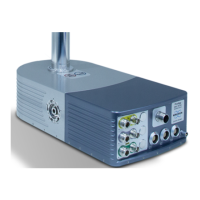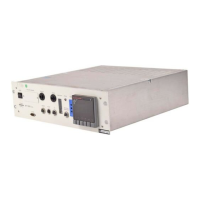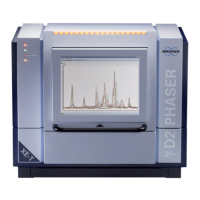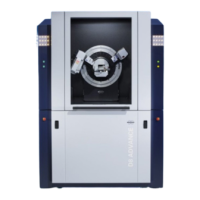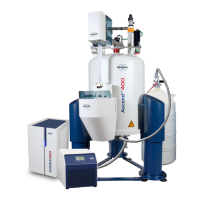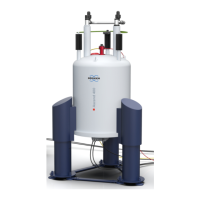Low temperature limit in sample cavity
CryoProbe User Manual BRUKER 45 (107)
Selection of CryoPreamps
To make full use of the CryoProbe’s signal-to-noise advantage, its built-in ‘cold’
preamplifiers must be selected for detection with crpon.
NOTE: After a power-on, the ‘warm’ preamplifier modules of the HPPR assembly
are selected by default - yielding the same result as a crpoff.
Depending on the kind of NMR experiment, it may be desired to observe a nucle-
us for which the CryoProbe has no built-in CryoPreamp but a decoupling channel
linked to a conventional ‘warm’ HPPR preamplifier module.
Example of a special setup
Task: Observe
13
C on a CryoProbe TXI in the presence of a high-sensitivity
2
H
lock.
Setup: In a CryoProbe TXI, the 13C channel is intended for decoupling only and
features no CryoPreamp. However,
13
C detection is possible when using the
warm HPPR 13C CRP preamp module. Send its output to the FT receiver but
feed the output of the build-in cold
2
H preamp into the lock receiver. This configu-
ration is established with crp2hon.
Possible combinations
See Table 4.7.
for all possible combinations of warm and cold preamps and their
corresponding X
WIN-NMR commands. The letter ‘X’ stands for any nucleus but
1
H,
e.g.
13
C,
15
N,
2
H. Of course, the build-in ‘cold’ CryoPreamps are to be preferred.
There are no waiting periods or the like needed when toggling between cold and
warm preamps.
More details are given in the CryoProbe RF Electronics Technical Manual.
Low temperature limit in sample cavity 4.11
0
The procedure described in this section is needed if measurements at or below
room temperature are planned. For the adjustment of the VT heater power limit,
the lowest temperature that can actually be reached in the CryoProbe sample
cavity, , must be known.
Table 4.7. Preamplifier selection
observe preamp lock situation X
WIN-NMR
1
H or X cold cold default crpon
1
H or X warm cold no CryoPreamp available for the
chosen nucleus; debugging
crp2hon
1
H or X cold warm debugging crp1hxon
1
H or X warm warm using a conventional probe;
debugging
crpoff
wobble warm warm tuning and matching any channel crpwobb
T
min
